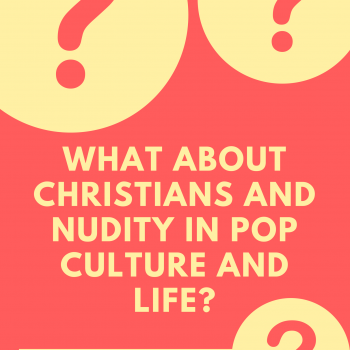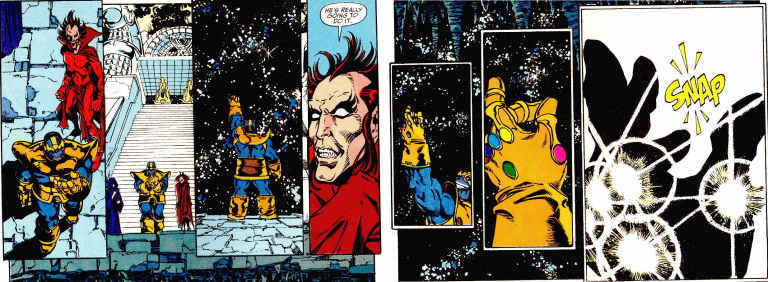
This piece is written as a companion to episode 11 of The Pop Culture Coram Deo Podcast and, like that episode (which you can play below, contains numerous spoilers. Read on at your own discretion.
Where did we come from?
What happens when we die?
These are among the most fundamental questions of human existence.
We should note too: these questions are necessarily questions of imagination. Both questions are unanswerable by our own experience and thus we have to speculate and even dream about their answers.
Small wonder, then, that the stories men produce continue to return regularly to both questions. These stories are imagination codified, dreams embodied within papyri, parchment, paper, and electronic text.
Dreaming Dreams, Nightmaring Nightmares
Again, men dream about what they will experience (i.e. death) and commit those dreams to mediums of communication. But “dream” here stands in for a concept English doesn’t really have a word for, which is the verb form of nightmare. One can hear “He dreamed a dream” and find the phrase familiar; “He nightmared a nightmare”, just as true to man’s experience as dreaming a dream, is much more foreign to human ears.
And yet nightmaring a nightmare is applicable to the way humans imagine life after death and their experience therein. This is because men are created in the image of The Holy One and have an intrinsic knowledge that people like themselves, namely unholy ones, deserve death for their unholy deeds and thus sense that a severe reckoning awaiting them on the far side of this mortal coil.[1]
As a result it is no surprise to find nightmaring nightmares showing up in the stories of men connected with death and after-death. Historians tell us that when 17th and 18th century communities saw their members growing weak from a disease they had no name or category for they provided an explanation for themselves from their native fear of death – something evil, they thought, had returned from beyond death’s veil to prey on their lives. More modern societies, wrestling with whether or not the scientific enterprise might betray us ultimately, also looks to beyond-death for an image to make our fears visual and thus the figure of the zombie rises to prominence in our stories. Men fear death and, as a result, populate their stories with ghosts and vampires and zombies as expression of that fear.
This is not meant to imply that the only stories we tell about death are grim and gory. Our old stories record that man has been imagining a happy ending concurrently with their narratives of fear. We read of fountains of youth and the apotheosis of Heracles and Psyche – all mechanisms that long for an escape from death. Others, falling into the mythology genre, assure their readers that things will go well for them after death if they uphold the virtues of the community during the hours of their lives.
Vibrant, Lovely, and Quite Risky
It is to this latter kind of death story that Pixar’s Coco belongs. The story of Coco is one filled with vibrant colors, warm family relationships, and the hope of a desirable existence beyond death. All of these elements combine into a heady brew which quickly provokes the imagination of old and young viewers alike, drawing them speedily in its lush vision of what awaits those who die. In this way the film that may be Pixar’s most aesthetically lovely is also potentially its most dangerous.

In Coco’s cosmology the world of the living and the world of the dead is separated by a gulf, yes, but one which grows incredibly thin during particular times of the year. Those who have died can visit (read: commune) with the living during the holiday. Those who are alive can improve the condition of after-life for their dead loved ones through prescribed actions in the living world. Most provocatively, Coco suggests that the dead can even improve their status in the afterlife through communing with their living neighbors. All well and good for an imaginative children’s story? Maybe. But also maybe not.
Watching Communing
Scripture is clear that communing with the dead is forbidden for those give their allegiance to The Living God.[2] One of the clearest texts on the subject is Deuteronomy 18:9-14.
When you come into the land [of Canaan] that the Lord your God is giving you, you shall not learn to follow the abominable practices of those nations. There shall not be found among you anyone who burns his son or his daughter as an offering, anyone who practices divination or tells fortunes or interprets omens, or a sorcerer or a charmer or a medium or a necromancer or one who inquires of the dead, for whoever does these things is an abomination to the Lord. And because of these abominations the Lord your God is driving them out before you. You shall be blameless before the Lord your God, for these nations, which you are about to dispossess, listen to fortune-tellers and to diviners. But as for you, the Lord your God has not allowed you to do this.
“There shall not be found among you… a necromancer[3] or one who inquires of the dead… the Lord your God has not allowed you to do this.” The prohibition from the Lord is quite clear. In reference to Coco it can accurately be said that most of what the main character does is commune with the dead.[4] Think too of Leviticus 19:28 – You shall not make any cuts on your body for the dead or tattoo yourselves: I am the Lord. Well-meaning but exegetically-misguided Christians have cited this text as a prohibition on all tattooing. What the text is actually prohibiting is participating in occultism[5], particularly in a way that attempts to bring the living into contact with the dead. The prohibition on tattooing yourselves is appropriately translated by the ESV but the Hebrew word has a larger lexical range, covering any kind of marking of the flesh on behalf of the dead.[6] And yet Coco is filled with imagery of marking yourself on behalf of the dead – living people dress up to celebrate Dia de los Muertos, some dressing as dead people for the celebration, and even Miguel dons deadface makeup to disguise himself while in the land of the dead.

Is the implication then that Christians should not watch Coco because of the film’s approach to living/dead relationships?
No, at least not if an individual Christian’s conscience allows for watching the movie.
Profitably Navigating Coco
The point here is to raise the very real tension between Coco and the prohibitions of Scripture, a tension that can get lost in the visual beauty of the film and the sometimes-supposed harmlessness of kids’ movies. That tension, rather than forbidding Coco, creates a need for careful thinking on the part of Christians about this film, particularly for those believers watching this movie with children.
The formation of a child’s moral imagination is of crucial importance in helping that child understand God’s world correctly. All stories disciple and Coco is no exception. With care the film can be a helpful vehicle for profitable discipleship. Left to its own devices, in contrast, the movie cuts down rather than cultivates.
Movies about death and what comes after, both of the horror-and-dread species and the it-all-works-out stripe, necessarily tell dangerously less than the truth if they do not communicate the fullness of the Bible’s revelation on what faces men and women after the end of their mortal lives. That doesn’t mean, however, that they both fail with equal gravity.
Perhaps counter-intuitively (particularly as it pertains to stories made for children), the stories that see death as something dreadful are less harmful than stories that paint a false vision of how to have a happy afterlife. You see, the Bible describes death as an enemy, an enemy with a powerful sting.[7] In somber tones it reminds those who think about death that judgment awaits after death.[8] Stories built on addressing death as something to be dreaded, something undesirable, something like an enemy tell a story closer to the truth than those (again, like Coco) that treat death as a grand adventure waiting to be had.
Yes, for certain (and thanks be to God!) Scripture tells a story about those for whom death is a portal into a better life. In doing so Scripture is very clear about the mechanism by which this better life after death is received: through faith in the crucified, resurrected, and reigning Jesus Christ. The afterlife goes well for an innumerable collection of individuals but a collection united in one truth: they are Christ’s people. It is in Christ that a man, woman, or child has confident expectation of a rich life beyond their death; for those outside of Christ there is expectation only of just judgment arriving in appropriate, eternal recompense for a life lived in rebellion against their good Creator.
An Authentic Path into the Grave
Coco obscures reality by asking us to imagine a world where the afterlife goes well not because Christ has made it so but by following our dreams and our sense of our most authentic self. This is a false gospel, an ungospel because it lies about the way of salvation and in doing so leads not to life but to eternal separation from God’s goodness. Coco’s Miguel is a boy shaped by his musical interest. In a way which invites the sympathy of the audience he breaks with his family’s strictures and finds that in pursuing his internal sense of being made to make music he not only finds his place in the mortal world but even redeems his grandfather in the land of the dead. Miguel is not only a redeemer but also a justice-bringer and he becomes both by, again, pursuing his sense of his most authentic self fearlessly.
While there is much to be admired in Miguel’s bravery he ends up being an avatar of our culture’s self-destructive commitment to the lie that our sense of what we want is the only roadmap to life. We have intentionally chosen to ignore that there is a way that seems right to a man but its end is the way to death. We have chosen to suppress the reality that our most authentic self is who our Creator made us to be and we know that self through the revelation our Creator has provided in His world, His word, and His Son. Coco’s Miguel makes our cultural delusion look cute and compelling but that doesn’t change the reality that following your sense of self, if that sense is disconnected from the moorings of God’s revelation, still terminates in eternal death.
Some examples:
- The spouse may feel that his or her most authentic self is the one living carefree with a lover who is not the husband or wife of their youth. This is a lie that leads to death. In reality, their most authentic self is found in faithful and self-sacrificing covenant-commitment to their spouse in a way that rejects all other lovers.
- The parent may find themselves believing their most authentic self is the one found when they are free from the trappings of their household to pursue what they believe is their calling, being musicianship (as with Coco’s Miguel) or travel, or any other desire that competes with their obligations to their family. This is a lie that leads to death. In reality, their most authentic self is the one who is united in loving service to their family and the joy of modeling God’s good Fatherhood in their homes.
- The individual experiencing a sexual appetite for the things God forbids in Scripture or a desire to reject the gendered identity in which God lovingly created them may believe that the good life awaits on the other side of indulging those appetites or surgery and hormone therapy. This is a lie that leads to death. In reality, their most authentic self is the one who understands themselves to be creature before their Creator and that the good life is found within a rightly ordered relationship of allegiance to and joy in that Creator.
The wise person will watch Coco in a way that accounts for the film’s pull toward believing a death-bringing lie. And the wise adult will help the children who watch Coco to see beyond the compelling and destructive delusion that following your fallen inclination to pursue your authentic self apart from the clarity of God’s revelation may indeed seem right but ends in death.
Vibrant, Lovely, and Immensely Compelling
One last note on the subject of Coco important for watching well:
As already mentioned, men and women want to imagine (and will sometimes nightmare) about life after death. Children will too. Why not lean into this when watching Coco? Or, more accurately, after watching Coco.
Coco as a film longs for certain things (because it is a product of people who long for these things and is consumed by people who long for the same): an assurance that there is a good future for us when we die, that we have hope of being reunited with those we love after our deaths, and more pointedly that we won’t be forgotten when we die.
Coco is such a beautiful film, both visually and in the way it tells us that the afterlife is beautiful, filled with our loved ones, and a joy to experience. Sadly, its story deceives about how those things will be had.
However – God has given all those things, and much more, beautifully so, to the church in Christ. Christ is the one who reliably sees to it that those who die in His care are received into the afterlife well.
Christ is the one who says that not only will He care for us but will do so for every one of our loved ones who are in Him through faith and that He will stand us alongside them (and alongside a new and beautiful family made up of His people from every tongue and tribe) in the joy of His glory for eternity.
Christ is the one who has unshakably committed to making sure that His people will never be forgotten, engraving their names in His own hands. When He comes for His people they will surely rise to Him – whether their grave is in a family cemetery, in the ruins of a sunken ship, or entirely forgotten to the record of history. He will remember where they lie and see to it that they rise to new life.
In all seriousness, as beautiful as Coco is, the film nonetheless cannot hold a candle to the beauty of what the prophets picture awaiting Christ’s church after death. Christ Himself is the great prize and beauty of Heaven! How could His presence and creative love not eclipse the pixels of Coco to the greatest degree?
Why not watch Coco with family and/or friends then sit down to read Isaiah 65, Zephaniah 3:9-20, and Revelation 21-22 (especially Revelation 21-22) as a way to look forward with longing and anticipation for all that the children of God will receive when they are visibly in Christ’s presence? It may be that the best use of this movie is to enjoy it as an opportunity to consider how much more wonderful the reality of what will actually come to pass for Christ’s people really is.
—————————————————————————————————–
[1] See Romans 1:18-32, particularly vs. 32 – Though they know God’s righteous decree that those who practice such things deserve to die, they not only do them but give approval to those who practice them.
[2] Leviticus 19:31; 20:6, 27; 2 Kings 21:6; 1 Chronicles 10:13-14; 2 Chronicles 33:6; Isaiah 8:19.
[3] “Form of divination in which a person calls upon the dead to receive communication that clarifies knowledge. Ugaritic texts from the middle second millennium b.c. attest to a belief in calling ancestors, even demonstrating that a deceased ancestor could be referred to as a god. Archaeological evidence from tombs at Ugarit support the possibility that libations or drinks were poured out to the deceased. Although the evidence is sparse, it seems to indicate that necromancy made up a part of the ancient Near Eastern world.” – Baker’s Evangelical Dictionary of Biblical Theology.
[4] Hang with me here, please, if you are inclined to think I’m taking the story of Coco too seriously.
[5] Read the immediate context: Leviticus 19:26-28.
[6] As the King James Version and Young’s Literal Translation have it.
[7] 1 Corinthians 15:26, 55.
[8] Hebrews 9:27












